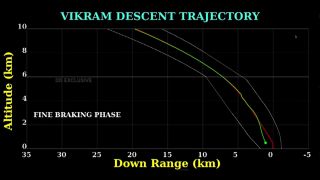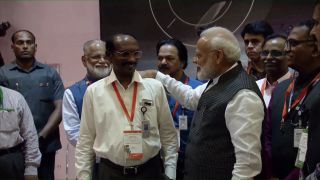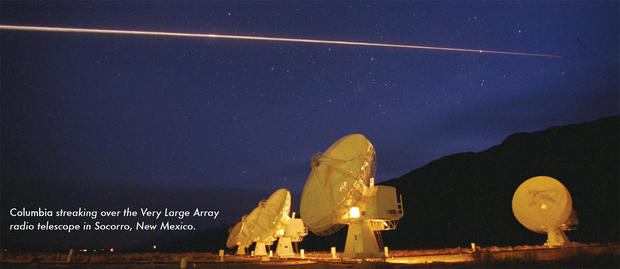India Loses Contact with Vikram Lander During Historic Moon Landing Attempt – Space.com
India lost contact with its Vikram lunar lander Friday (Sept. 6) during a daring attempt to make history as the first country to land near the south pole. The landing anomaly may have dashed Indian dreams of becoming just the fourth country to successfully soft-land a spacecraft on the moon.
Long, tense minutes stretched out inside the mission control center for the Indian Space Research Organization (ISRO), which designed the Chandrayaan-2 spacecraft. Prime Minister Narendra Modi had arrived onsite at the Satish Dhawan Space Center in Sriharikota, India, about half an hour before touchdown of the landed component, dubbed Vikram, was scheduled to take place.
That announcement came at 4:48 p.m. EDT (2048 GMT) from K. Sivan, the director of ISRO. “Vikram lander descent was as planned and normal performance was observed up to an altitude of 2.1 kilometers [1.3 miles],” Sivan said in an announcement at mission control. “Subsequently the communications from the lander to the ground station was lost. The data is being analyzed.”
Related: India’s Chandrayaan-2 Mission to the Moon in Photos

Data comparing the planned trajectory of the Vikram lander with telemetry from the spacecraft.
(Image credit: ISRO)
Modi spoke after Sivan’s announcement, appearing to bolster downcast spirits in mission control as they investigated the issue. “Be courageous,” he said.
“What we achieved is not small,” Modi added. “Wish you all the best.”
Sivan did not specify when ISRO would be able to provide updates about the fate of the Vikram lander. According to data shown during the descent maneuver, the lowest altitude reported back to Earth was 0.2 miles (0.33 kilometers) above the lunar surface.
A plot comparing live data received to the mission’s trajectory suggested that Vikram was about 0.6 miles (1 km) horizontally off-track from the targeted landing site when communications stopped.
“India is proud of our scientists!” Modi wrote in a Twitter update shortly after learning of the anomaly. “They’ve given their best and have always made India proud. These are moments to be courageous, and courageous we will be!”
“We remain hopeful and will continue working hard on our space programme,” he added.
Chandrayaan-2 consisted of three components — an orbiter, a lander named Vikram and a rover named Pragyan — which together launched to the moon on July 22 atop a Geosynchronous Satellite Launch Vehicle Mark III (GSLV Mk III) rocket. It took nearly 7 weeks to arrive at its destination; Chandrayaan-2 arrived in lunar orbit on Aug. 20, and the lander separated from the orbiter on Sept. 2 to begin its descent to the lunar surface.
The lander and the rover were designed to spend one lunar day — about 14 Earth days — investigating the lunar surface with a variety of scientific instruments. Both were expected to shutdown come nightfall at the moon’s south pole, because they weren’t built to withstand to frigid temperatures of the lunar night.

Prime Minister Narendra Modi spoke with ISRO director K. Sivan after the agency lost communications with the Vikram lander.
(Image credit: ISRO)
Despite the demise of the Pragyan lunar rover and Vikram lander, the Chandrayaan-2 orbiter will continue studying the moon from afar for about a year.
From its vantage point at an altitude of about 62 miles (100 kilometers) above the moon’s surface, the orbiter uses eight scientific instruments and cameras to study Earth’s natural satellite from afar. The following are among the payloads:
- An X-ray spectrometer to measure the abundance of different elements on the moon.
- A solar X-ray Monitor, which studies high-energy radiation from the sun.
- A dual-frequency synthetic aperture radar to map the lunar surface.
- The Chandrayaan-2 Atmospheric Compositional Explorer 2 (CHACE 2), which studies the composition of the moon’s exosphere, or ultrathin atmosphere.
- A radio science experiment that will study electrons in the moon’s ionosphere.
Today’s possible failure may mark the second time ISRO has crash-landed a spacecraft on the moon. The country’s first lunar mission, Chandrayaan-1, launched in 2008 and consisted of only an orbiter, which successfully conducted vital research at the moon, and an impactor. Chadrayaan-1 operated for about 10 months.
Chandrayaan-2 bears some similarities to Chandrayaan-1, but it carried new and improved technologies that ISRO is testing for future planetary missions — like its next mission to Mars.
India had announced tentative plans to launch a third moon mission called Chandrayaan-3 in 2024. Like Chandrayaan-2, that mission would include a lunar rover.
India was striving to become the fourth country to soft-land on the lunar surface, after the United States, Russia and China. The fatal crash of the Vikram lander comes just months after Israel’s first moon mission, Beresheet, met a similar fate.
But unlike Beresheet, Chandrayaan-2’s mission lives on in the orbiter that will circle the moon, alone two weeks before its time.
Email Meghan Bartels at mbartels@space.com or follow her @meghanbartels. Email Hanneke Weitering at hweitering@space.com or follow her @hannekescience. Follow us on Twitter @Spacedotcom and on Facebook.






